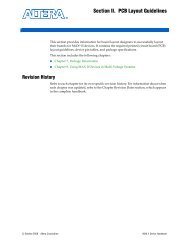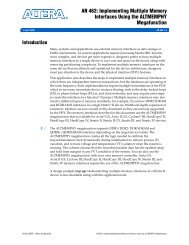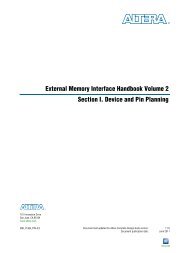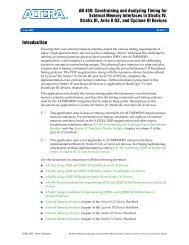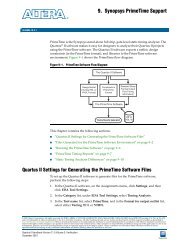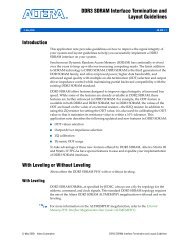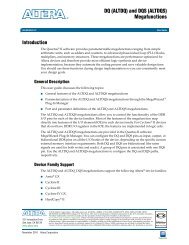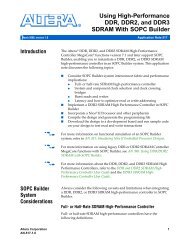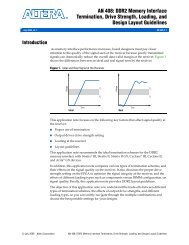MAX 9000 Programmable Logic Device Family Data Sheet
MAX 9000 Programmable Logic Device Family Data Sheet
MAX 9000 Programmable Logic Device Family Data Sheet
You also want an ePaper? Increase the reach of your titles
YUMPU automatically turns print PDFs into web optimized ePapers that Google loves.
<strong>MAX</strong> <strong>9000</strong> <strong>Programmable</strong> <strong>Logic</strong> <strong>Device</strong> <strong>Family</strong> <strong>Data</strong> <strong>Sheet</strong><br />
All <strong>MAX</strong> <strong>9000</strong> device packages provide four dedicated inputs for global<br />
control signals with large fan-outs. Each I/O pin has an associated I/O<br />
cell register with a clock enable control on the periphery of the device. As<br />
outputs, these registers provide fast clock-to-output times; as inputs, they<br />
offer quick setup times.<br />
<strong>MAX</strong> <strong>9000</strong> EPLDs provide 5.0-V in-system programmability (ISP). This<br />
feature allows the devices to be programmed and reprogrammed on the<br />
printed circuit board (PCB) for quick and efficient iterations during design<br />
development and debug cycles. <strong>MAX</strong> <strong>9000</strong> devices are guaranteed for 100<br />
program and erase cycles.<br />
<strong>MAX</strong> <strong>9000</strong> EPLDs contain 320 to 560 macrocells that are combined into<br />
groups of 16 macrocells, called logic array blocks (LABs). Each macrocell<br />
has a programmable-AND/fixed-OR array and a configurable register with<br />
independently programmable clock, clock enable, clear, and preset<br />
functions. For increased flexibility, each macrocell offers a dual-output<br />
structure that allows the register and the product terms to be used<br />
independently. This feature allows register-rich and combinatorialintensive<br />
designs to be implemented efficiently. The dual-output<br />
structure of the <strong>MAX</strong> <strong>9000</strong> macrocell also improves logic utilization, thus<br />
increasing the effective capacity of the devices. To build complex logic<br />
functions, each macrocell can be supplemented with both shareable<br />
expander product terms and high-speed parallel expander product terms<br />
to provide up to 32 product terms per macrocell.<br />
The <strong>MAX</strong> <strong>9000</strong> family provides programmable speed/power<br />
optimization. Speed-critical portions of a design can run at high<br />
speed/full power, while the remaining portions run at reduced<br />
speed/low power. This speed/power optimization feature enables the<br />
user to configure one or more macrocells to operate at 50% or less power<br />
while adding only a nominal timing delay. <strong>MAX</strong> <strong>9000</strong> devices also<br />
provide an option that reduces the slew rate of the output buffers,<br />
minimizing noise transients when non-speed-critical signals are<br />
switching. <strong>MAX</strong> <strong>9000</strong> devices offer the MultiVolt feature, which allows<br />
output drivers to be set for either 3.3-V or 5.0-V operation in mixedvoltage<br />
systems.<br />
4 Altera Corporation




